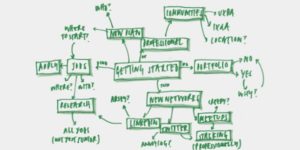 Tim Caynes, a Principal Designer at Foolproof, with his advice for budding experience designers.
Tim Caynes, a Principal Designer at Foolproof, with his advice for budding experience designers.
Entering the field of experience design may seem daunting, but it’s an expanding and rewarding field to get into. Getting your first role as a designer in this field isn’t easy, but I can help.
I have career advice. I’ve been around long enough to do most of the things you shouldn’t do and see most of the things you really don’t want to see.
Much of that time was spent tactically hunting for roles.
Most of that time was spent trying to assess candidates applying for roles.
A lot of that time was a waste of time.
But in this blog, I’ll give you the best advice I can about how to kick-start your user experience design career. Whether you’re wondering where you go after walking squinty-eyed out of the union building for the last time, or you have a couple of years of in-house or agency-based design experience, I’ve made a list of things for you. This list contains five things that will be invaluable to propelling your career forward. Honestly.

Start looking
I actually mean start stalking. But, professionally. If you take nothing else away from the following incoherent ramblings, take away this: you need to be the first name on someone’s brain list when an opportunity explodes. And there are specific ways you can begin to find these opportunities and worm your way into people’s brains.
First things first, get on board with the User Experience Professionals Association (UXPA) and Interaction Design Association (IXDA). They’ve got countless resources, reading materials, and up-to-date job listings on their sites. All of which can help ground your search.
Oh, and they do careers events regularly. Which you need to be at. I’ve employed people directly from those events. There are countless events like this to attend over the course of the year, make sure you identify them. Try Eventbrite and Meetup.
Studiously and relentlessly trawl job listings. Duh. Also invest in researching company, brand and business websites – make notes and take names. Having an order of preference is also useful – try thinking about who you’d like to work for and why.
I shouldn’t need to tell you that being social can help. LinkedIn is your friend, as is social media advocacy generally. LinkedIn is a professional network so it carries some weight if you connect politely and have a story to tell. Mind you, it’s also full of eye-wateringly painful pseudo-inspirational arse, so be focused.
Maybe better, you just find a voice on Twitter and demonstrate that you are a half-decent human with opinions and ideas. If I meet you at a careers fair, I’ll subsequently find you on Twitter, because that’s where I begin to understand you personally. Follow big names in design, share and comment on their content, the same applies to prospective employers. Like me (The prospective employer bit).
Attend experience design and related events around you – this will help you get to know who’s who in your local area. Co-ordinating your event attendance with that of stakeholders/current employees of potential employers you’ve identified from job listings is the best use of your time. Attending events also allows talent scouts to get to know you in a less professional setting. It’s by far the best way to start a conversation. Trust me.
Be tactical
When looking around you’re likely to come across job titles such as: UX Designer, Interaction Designer, Experience Architect, Innovation Architect, Dribbbling Twit – to name but a few. However – somewhat unhelpfully – few of these jobs will ever be labelled graduate or junior.
Many will ask for 1-2 years of experience but don’t be deterred, they’ll often be suitable for graduates. Particularly those with a good showcase of work. That 1-2 years thing is an evil trick designed to destroy the hopes and dreams of young lambs, whipping their bouncy little legs from under them as they frolic into the real world. Your experiences and skills are more valuable and relevant than you might think – getting your first job is more about you and how you come across rather than your apparent wealth or lack of work experience.
Remember: always enquire, even if no jobs are advertised. This shows that you’re keen, gets your name on the brain list for future vacancies and (if you come across well) you could land yourself an initial meeting, or another contact they know who you can reach out to. You don’t have to be formally applying for a job to talk to someone. I’ll have a chat with you if you ask.
During an event last year Amy Shore, a Senior Consultant at Foolproof, talked about how reaching out to people and attending events led her to Foolproof. She was just asking for help and advice for her thesis and that helped her build connections in the industry. You can see more of what she said in our video on leadership advice.
Show things
Always have a portfolio on hand. Well, I say always. I actually have an existential disquiet regarding the need to have a portfolio, but I’m afraid you need one.
This should be a showcase of the work you’re proudest of and most confident about, whether that’s evidencing your university projects design and process, your designs which have made it into the real world, or work you’ve done in your own time just for fun. The most important thing however, is that you demonstrate how you respond to a brief, consider outcomes, and iterate on ideas. A portfolio discussion is a whole other world of pain, but, you probably need one, right?
Above all you should just be showing your work at every opportunity. Just show things. Whether that’s a personal portfolio site, or having a strong social media presence, you need to invest, where you can, to show what you could bring to a potential employer. Or just to show you’re pretty cool.
Using community platforms such as Dribbble or Instagram to showcase your designs can help you gain a following, are great for amplifying your voice, and are often the best way to collect evidence.
Wrapping up your degree show? Capture that. Working for a couple of weeks at an agency? Capture that. Work experience or training course? Capture that. Capture everything.
Oh, and as soon as you become known to me, I’ll Google you. Don’t make stuff up. Don’t be vague. Don’t inflate your participation to the point of it becoming all your idea. People will see through that.
Be unique
You need to get your prospective employer onside and invested in you. If you want to work in experience design you have to have an active, demonstrable interest in experience design. That means having an opinion wider than just the application of typefaces in airline boarding pass redesigns (although we can clearly have long conversations about that). Seek out and discuss a wider range of topics from across the experience design practice. If you don’t even know what I mean by that you should probably start there, but the important thing is that you have your opinion. Who are you? How do you think? I’ll be looking for that thing that makes you who you are.
Align your skillset with what the company you’re applying to is looking for – this means tailoring your CV to fit with these requirements. Drawing out particular aspects guides the reader and offers a hierarchy to the information you’re presenting them with.
In other existential crises, I also weep at CVs that are simply a checklist of things. Even if you draw a neat icon which tells me you’re 80% good at Photoshop, it’s still pretty meaningless. Tell me what you’ve done and how and for who. I’m going to assume you know how to learn how to use software.
Companies often want to know what you can bring with you to the team. Being hired is down to the balance of your skills and who are as an individual combined with how you can enhance or build on existing company culture.
Top Tip: If you only have one chance to tell me who you are and what makes you interesting or different, it’s often first contact. If your first contact is because you’re sending a CV, make your case in a covering letter and evidence your achievements and skills in your CV. And then pin your covering letter to your CV so people have to read it as one document (save it all in one PDF).
Be visible and knowledgeable
Tie the four points above together to help discover your voice, establish your design credentials, or simply get out there and express an opinion.
Relentlessly educate yourself: read experience design blogs and articles, learn to use new applications, meet new people and talk about design. Participating in meetups, seminars and conferences give you a sustained opportunity to catch the inside design track.
Top Tip: Volunteering as a student helper can allow you to gain access to many events where the design conversation is happening. And where the happening people are. And also me.
Research, research, research: Know the company you’re applying for inside out, what have they been designing lately? What do you like about the experience? Can you say something or ask something interesting about it? No detail is too small. It should be no surprise that candidates with little knowledge of the company they are applying to don’t get very far. I’ll be asking questions…
Summing up
Despite these five listy things I’ve laboured over for you, a lot of being hired in your first role, or any role come to that, comes down to a matter of like and dislike. Don’t feel disheartened if you don’t hit it off with everyone who interviews you. Not everyone will like you for you and that’s okay. Equally, don’t feel obliged to accept every opportunity that comes your way if you aren’t comfortable. Being hired is as much about you as it is about your prospective employer: neither party should take the plunge unless you’re all feeling positive.
This post originally appeared on the Foolproof website.
